Let’s talk about the only “market timing” strategy that actually works in practice – buying a stock before it announces a dividend hike.
In a minute, I’ll show you seven stocks that are likely to announce generous hikes next time they talk to Wall Street. Their stock prices will then follow their payouts higher in the ensuing months.
This “undercover income strategy” is the closest thing to a sure thing you’ll find in the financial markets. Everyone loves the dividend, but investors usually don’t give enough love to the dividend hike. Not only do these raises increase the yield on your initial capital, but also they often are reflected in a price increase for the stock.
For example, if a stock pays a 3% current yield and then hikes its payout by 10%, it’s unlikely that its stock price will stagnate for long. Investors will see the new 3.3% yield, and buy more shares.
They’ll drive the price up, and the yield back down – eventually towards 3%. This is why your favorite dividend “aristocrat” – a company everyone knows and has paid dividends forever – never pays a high current yield. Its stock price rises too fast!
For example let’s look at UPS (UPS), which always seems to pay between 2.5% and 3%, give or take. This yield already gets you ahead of the game in today’s low rate world. Next, let’s consider the stock’s price appreciation which moves remarkably in tandem with its dividend:
UPS Payout Drives Stock Price Growth
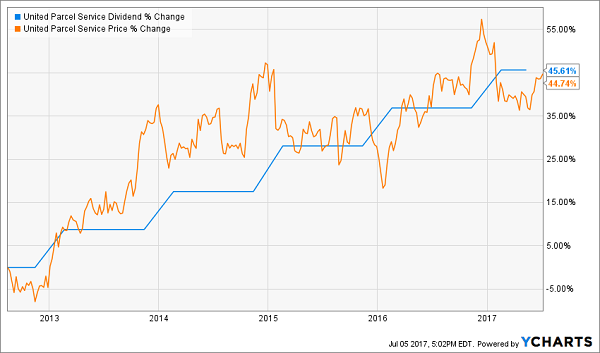
UPS increased its dividend by 45.6% and its stock rose 44.7%. That’s no coincidence.
Boeing (BA) is an even better example. I recommended the stock to my Hidden Yields subscribers in December 2015 when its stock price (blue line) began to lag its soaring dividend (orange line). That was our cue that this stock was due to “catch up.”
That’s exactly what unfolded. We’ve nearly doubled our money (93.5% total returns) in less than two years.
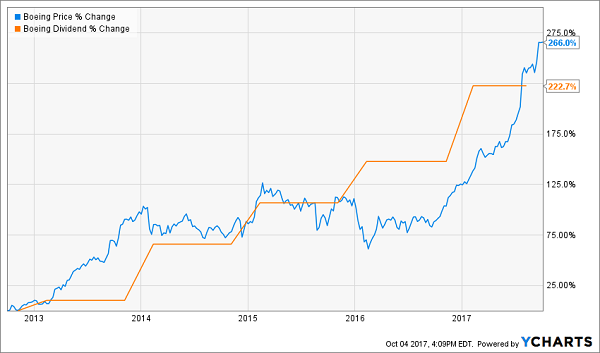
Since share prices move higher with their payouts, there’s a simple way to maximize our returns: Buy the dividends that are growing the fastest.
Here are seven that are due for a boost:
Amgen (AMGN)
Dividend Yield: 2.6%
Biotech stocks aren’t the first, second or third name in the income game, but one or two stocks are exceptional exceptions.
Take Amgen (AMGN), which has more than tripled its quarterly payout in five years, from 36 cents per share in 2012 to current levels at $1.15. That’s because Amgen is no fly-by-night biotech small-cap that lives and dies by trial results for one or two candidates. AMGN operates in approximately 100 countries, and boasts 16 products already approved in the U.S. – and that’s not to mention its robust pipeline of 33 clinical and pre-clinical treatments.
Amgen grew its top line once again last year, to nearly $23 billion, that delivered a tidy $7.7 billion profit. And Amgen uses its growing earnings to fund stark growth to its quarterly payout. Expect the next increase to be announced sometime in mid-December, though the dividend itself won’t be paid until February of the following year.
Amgen (AMGN) Is One of Biotech’s Few Dividend Champs
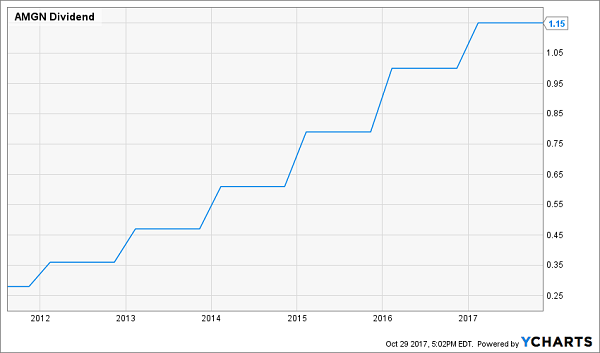
Boeing (BA)
Dividend Yield: 2.2%
Aerospace and defense giant Boeing (BA) has, as mentioned, already given shareholders a 2017 they won’t soon forget. BA shares have climbed more than 60% year-to-date, powered by good, old-fashioned operational excellence. The company has posted three earnings beats through three reports this year, and that included a record 202 aircraft deliveries in its third quarter reported in late October. That Q3 report also included an upgraded forecast for free cash flow (from $12.25 billion to $12.5 billion) and earnings (from $11.10-$11.30 to $11.20-$11.40).
Boeing should share some of that extra wealth sometime in mid-December, when the company traditionally announces its annual dividend hike. Investors can only hope this year’s increase is like last year’s, when it ratcheted up the payout by 30%.
Will Boeing (BA) Deliver Another Dividend Gem for the Holidays?
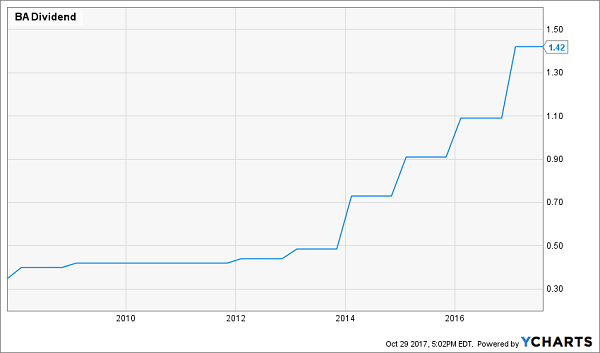
Buckeye Partners LP (BPL)
Distribution Yield: 9.6%
Buckeye Partners LP (BPL) is a pipeline master limited partnership (MLP) largely dedicated to transporting and storing liquid petroleum products, boasting some 6,000 miles of pipeline. But what makes BPL truly stand out is its dedication to distribution increases – the company has upped its payout on a quarterly basis since 2013, and likely will do so again Nov. 3 alongside its third-quarter results.
Just don’t expect much. The scale of BPL’s distribution improvements has slowed to a near-crawl, and likely will underwhelm again given the MLP’s disappointing year; shares are off more than 20% so far amid a downturn in profits.
Buckeye Partners’ (BPL) Distribution Continues to Crawl Higher
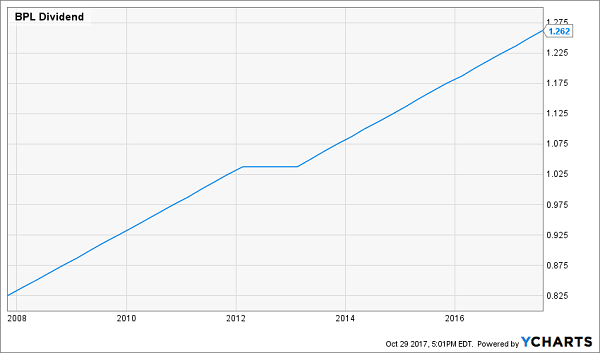
Cedar Fair LP (FUN)
Distribution Yield: 5.5%
Cedar Fair LP (FUN) is the company best known for Ohio’s Cedar Point – the world-class thrill park whose coasters frequently rank among the tallest, fastest and/or longest in the world. However, it also is responsible for parks such as Kings Island, California’s Great America and Knott’s.
Cedar Fair is among the beneficiaries of the growing “experience economy,” in which Americans have become more interested in going out and experiencing the world than simply accumulating stuff. Between continued growth and a considerable distribution, FUN shares have actually outpaced the S&P 500’s total return over the past five years.
Cedar Fair has more than doubled its distribution since 2012, from 40 cents quarterly then to 86 cents now. That payout should get even larger in early November, when the company typically unveils a higher number.
Cedar Fair (FUN): Perfect for Thrill Seekers and Income Seekers Alike
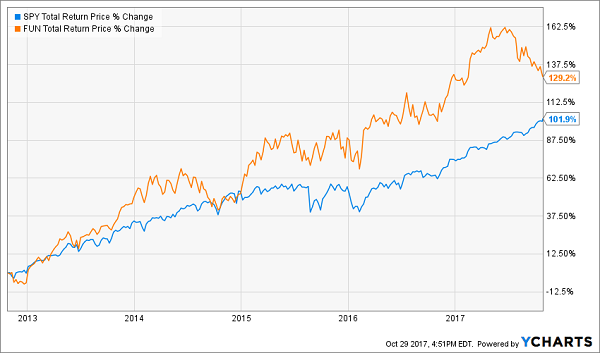
Six Flags (SIX)
Dividend Yield: 4.1%
Six Flags (SIX) looks a lot like Cedar Fair in that it’s an amusement park-related operator with an attractive yield. It currently boasts 20 parks across the U.S., Canada and Mexico – most of them either Six Flags-branded or joined water parks – and has plans to open three branded parks in China. And like Cedar Fair, Six Flags has pummeled the S&P 500 on a total return basis over the past five years.
But SIX and FUN have a few important differences. Most notably, Cedar Fair is a limited partnership that pays distributions, and thus requires the complicated K-1 form come tax time; Six Flags is a traditionally structured business with simple dividends.
On the flip side, Six Flags’ payout growth hasn’t been as substantial as Cedar Fair’s, with a 42% improvement to the dividend since 2012. Still, investors should be on the watch for a fresh hike to be announced sometime early in November.
Six Flags (SIX) Keeps Climbing the Mountain
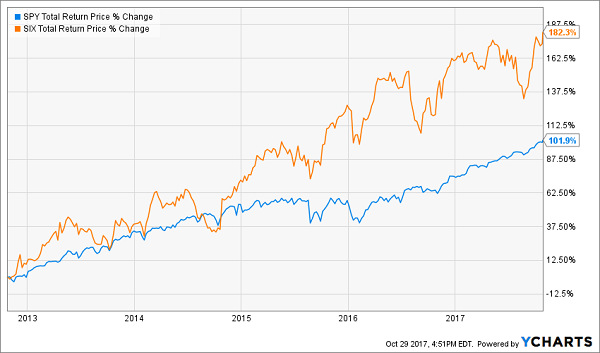
Starbucks (SBUX)
Dividend Yield: 1.8%
America’s coffee king, Starbucks (SBUX), is in dire need of a little caffeine. Shares are down 13% since 2015 amid continued growth concerns – and yet at the same time, the stock still can’t shake its perpetual state of being overvalued. SBUX trades for more than 23 times forward earnings right now, which is more expensive than the also-frothy S&P 500 (nearly 20), and estimates for roughly 15% earnings growth don’t really justify the premium.
However, another dividend boost like Starbucks doled out in 2016 might stay a few hands that are ready to sell. The company hiked its quarterly payout by a whopping 25% to 25 cents per share. Investors should find out how much more SBUX will pay out on Thursday, Nov. 2, when the company announces its results for the full fiscal year.
Will Starbucks’ (SBUX) Growth Problems Extend to Its Payout?
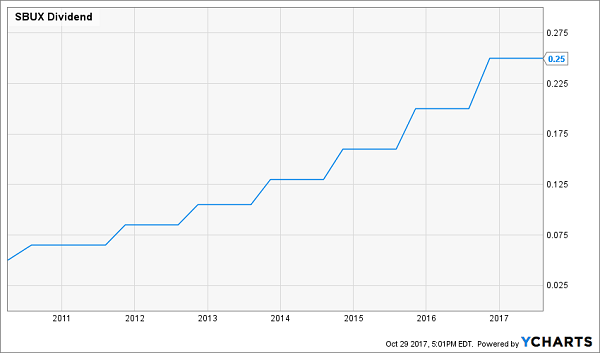
Universal Corp (UVV)
Dividend Yield: 3.9%
Universal Corp (UVV) is, like other tobacco stocks, a good yielder that’s surprisingly resilient despite the country’s continued, longstanding crackdown on tobacco products. But it’s also unlike other tobacco stocks.
Universal is instead a buyer and seller of tobacco, so rather than competing with the likes of Altria Group (MO), it actually counts the parent of brands like Marlboro and Parliament among its customers.
Universal Corp (UVV) Has a Long History of Dividend Hikes
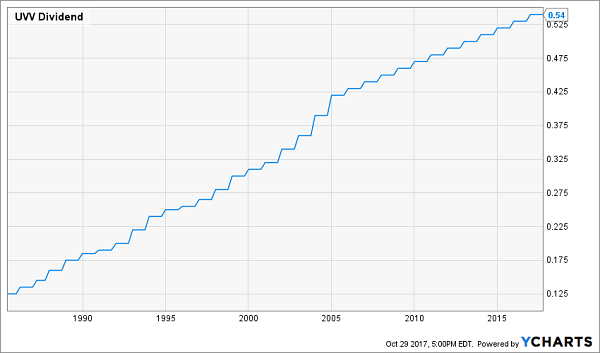
UVV shares haven’t enjoyed a boffo 2017, down about 10% with just a couple months to go in the year. However, Universal is a dividend raiser in good times and bad, including clockwork penny-per-share hikes since 2006. Universal’s announcement typically comes sometime in the first half of November.
“Back Up the Truck” on Dividend Growers – Like These 7
How much money should you allocate to dividend growth?
As much as possible. This strategy is such a “slam dunk” for investing returns that there’s no reason to collect more current yields than you need right now. If you can “forego” some amount of income today, I would encourage you to consider investing that capital into dividend growers.
It’s a simple three-step process:
Step 1. You invest a set amount of money into one of these “hidden yield” stocks and immediately start getting regular returns on the order of 3%, 4%, or maybe more.
That alone is better than you can get from just about any other conservative investment right now.
Step 2. Over time, your dividend payments go up so you’re eventually earning 8%, 9%, or 10% a year on your original investment.
That should not only keep pace with inflation or rising interest rates, it should stay ahead of them.
Step 3. As your income is rising, other investors are also bidding up the price of your shares to keep pace with the increasing yields.
This combination of rising dividends and capital appreciation is what gives you the potential to earn 12% or more on average with almost no effort or active investing at all.
Which “hidden yield” stocks should you buy today? Well you know me – I’ve got seven best buys that should safely double your money every three to five years.
It’s a simple formula – their dividends are doubling every three to five years, which means their prices will rise in tandem. At the same time, we’ll collect their dividend payments today and enjoy an even higher income stream tomorrow.
This dividend growth strategy has produced amazing 27.1% annualized returns for my Hidden Yields subscribers since inception. In two-plus years, we’ve crushed the broader market (the S&P 500 returned 16.1% over the same time period.)
If you achieve returns of 27.1%, you’ll double your money in less than three years. So if you haven’t been following this strategy, why not? The best time to get started is right now – before the seven dividend growers I mentioned begin to move. Click here and I’ll share their names, tickers and buy prices with you right now.

Recent Comments